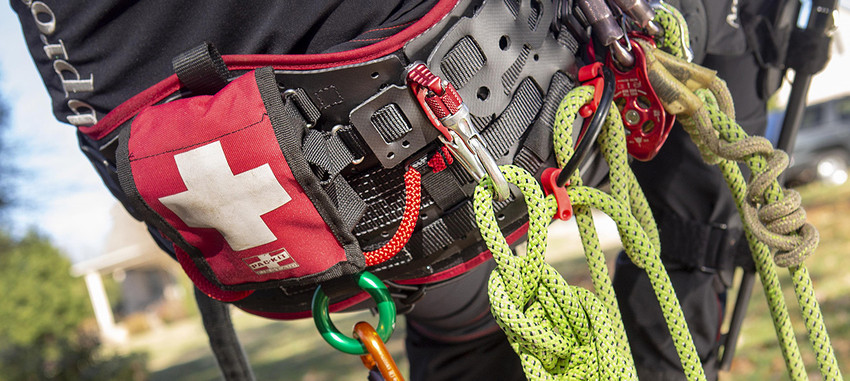TFTC #27 A Must Have (but hope to never use) Kit
Sherrilltree Jun 10th 2021Several shiny tools and devices beckon us to click Buy Now! Mechanical hitches, ascenders, swivels, and such make our lives easier while we’re aloft, but what about first aid kits? The excitement dies, right? I mean, it’s just going to sit there. But, considering that national statistics point the finger at tree related work as one of the most fatal occupations, it’s crucial to plan for the worst.
In addition to proper training (a requirement for all crews, by the way [ANSI Z133 Part 3]), proper equipment is an essential part of any emergency plan. So what’s what among the kits out there, and which ones best fit your team’s needs?
The Kits
First, it’s imperative that every crew is equipped with a first aid kit that complies with ANSI Z133 Part 3. It must be labeled and always stocked to meet or exceed minimum requirements. If someone uses part of it, and it no longer contains the minimum stock, it must be restocked or replaced. This logger kit is compliant for up to 10 crews. Be sure that standard kits like this one are easily accessible, and that every crew member knows where to find them on the jobsite.
Besides standard, compliant kits, blood trauma kits are popular options due to the likelihood of arborist injuries to include contact with a saw, whether a chainsaw or handsaw. Check out a great how-to on using trauma kits in the field.
There are a couple different kit options out there- let’s have a look!
The Sherrrilltree bloodstopper kits equip climbers with a bloodstopper bandage in a low profile case that attaches easily to many saddles. Other supplies can be added to suit the risks of the situation. One of the kits contains WoundSeal to help stop bleeding. These kits are simple, small, and customizable.
Silverbull’s Personal Arb Trauma Kit (P.A.T.) also reflects the principles of small and simple, while providing the more advanced combat-style tourniquet. This kit was developed by consulting with arborist first-aid trainers, and it shows. It’s not as customizable, but can be stored in several locations for quick, easy access. The looped cord deploys the pouch’s contents when pulled- a helpful feature in an emergency setting!
TacMed’s Arborist Medical Kit is the largest among the blood trauma kits. The bulk is a trade-off for the additional supplies contained within- a tourniquet similar to the P.A.T.’S, bandages, trauma shears, and gloves.
“In addition to proper training, proper equipment is an essential part of any emergency plan.”
Finally, Edelrid’s Treerex First Aid Bag features a unique design for emergency use. The pull cord that attaches to the exterior is meant to be installed on a saddle so that the green tab is easily accessible to the climber. In the event of an emergency, if the kit is properly installed, the cord can be pulled to bring the kit to the front of the saddle for easy access. Note- this bag contains NO first aid supplies. It is a blank slate for a fully customized kit.
Which One(s) to Get?
The best kit to get is the one that matches the hazards a team faces and whose contents the team is trained to use. Whether your team sees value in having kits aloft or prefers to have them accessible on the ground, take the time to go over the kits and ensure everyone knows how to use them properly.
The American Red Cross’s StopTheBleed campaign holds events in cities across the U.S., many of them free, that teach attendees how to treat blood trauma in first aid scenarios. Otherwise, local EMS may be willing to review your trauma kit and educate your team on its use. Even If they aren’t, any EMS department should be familiar with what training resources are available in your area.
For some great info on responding to blood trauma, check out these posters by StopTheBleed:

